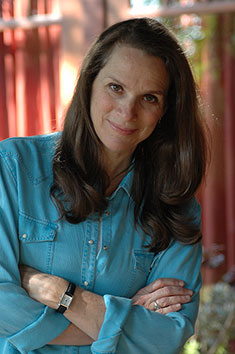More mysterious are the contours of an old ranch down in Rustic Canyon, which later became a retreat for artists and writers like David Hockney and Christopher Isherwood. Among the orchards gone wild, the remains of a magnificent stone gate designed by the architect Paul Williams come into view.
Local stories about this piece of property, which was destroyed in a 1978 fire, abound. Randy Young, a Pacific Palisades resident and amateur historian, insists that during World War II, Norman and Winona Stephens used their land as a sort of Nazi outpost. Mr. Young says the couple thought that when Germany conquered England, there would be anarchy in the United States and they would run a self-sufficient command site where a new government could arise, accounting for the concrete power station and million-gallon storage tank that still stand.
Continuing along the trail, marked by hoof marks in the early-morning hours, we walked northwest about five miles, crossing a footbridge and then passing a horse and rider, two mountain bicyclists and two joggers. A red-tailed hawk soared overhead.
Given enough time and supplies, we could have walked all day, eventually ending up amid ferns at the Santa Ynez Falls in Topanga State Park. Or farther west, there is the Circle X Ranch site and Sandstone Peak, the mountains' highest point at 3,111 feet. But hungry and carrying only water and pieces of melon, we returned to visit the historic Will Rogers home, patterned after a hunting lodge in Montana.
We were struck first by the vast expanse where Rogers and his three children played polo, and then began to fantasize about drinking martinis on his outdoor patio beside the birds of paradise. Will Rogers, we learned on a tour, had anonymously donated millions to the Red Cross and Salvation Army during the Great Depression. His ranch, with its exquisite Navajo rugs and giant western Apache basket, also has what must be the world's niftiest wraparound chrome shower as well as Rogers's 1927 portable Remington typewriter, on which he tapped out lines like, ''Everybody's ignorant, only on different subjects.''
The next morning, under an azure sky, we drove 17 miles northwest from Santa Monica along the Pacific Coast Highway and discovered the delicious serenity of Solstice Canyon, one of the only canyons along the Santa Monica Mountains coast that harbors a perennial stream and an uninterrupted creek-side trail, shaded by sycamores and oak. From the parking lot, where a bizarre, glass-floored home (locals call it ''the Darth Vader house'') hangs over the neighboring hillside, we followed the creek past National Park Service offices and along a cement road that leads past the gorgeous Mathew Keller house, built in 1865 of blond stone and believed to be the oldest house in Malibu.
Feeling a noticeable shift in humidity, we soon arrived in a lush setting known as the Tropical Terrace with a view of grotto waterfalls, rock pools, palms and bamboo -- part of the remains of the 556-acre Roberts ranch, destroyed by a 1982 fire. In fact, to hike this trail is to understand how tenuous is man's hold on the landscape, as floods and fires drive people out and earthquakes keep moving these mountains closer to the sea.
Ascending the upper loop of the Sostomo Trail, about three miles south of the Backbone, we discovered a giant, sphinxlike boulder facing the sea as we spotted Catalina Island across the bay from the park's upper slopes. Then, after admiring a blue jay and some of the rare fall foliage to be found in Southern California, we suddenly realized we hadn't seen another soul in two hours. We retraced our steps, descending and crossing the stream to complete the six-mile stretch back to civilization.
One reason so much land in the Santa Monica Mountains has been preserved from development is that both Paramount and 20th Century Fox studios owned vast tracts of it. In fact, it's impossible to trek the Backbone pathway and not have a sense of deja vu. One leg of the trail, on the Paramount Ranch site in Malibu Creek State Park -- the location for shooting the TV series ''M*A*S*H'' -- suggests Korea; another, a few miles north, thanks to ''Dr. Quinn, Medicine Woman,'' an Old West mining town. The National Park Service offers a one-hour tour called ''From Set to Screen,'' of the site where ''Dr. Quinn'' is filmed.
The following day, instead of another rigorous hike, we opted for a tea-and-scones garden tour of the Streisand Center for Conservancy Studies north of Malibu, across the Pacific Coast Highway from Paradise Cove and behind an Art Nouveau electronic gate.
''We don't do Barbra Streisand tours,'' said Ruth Kilday, executive director of the nonprofit Mountains Conservancy Foundation, which has taken up residence on Ms. Streisand's former estate. Despite such disclaimers, it's impossible for the Barbra trivia not to seep out during Ms. Kilday's delightful tour of the 22-acre compound, bordered by National Park Service land on three sides. We learned, for instance, that Ms. Streisand's herb garden was planted soon after her relationship with Jon Peters ended. And that James Brolin, Ms. Streisand's current beau, ''just fills up a room, he's so gorgeous.'' And that the kitschy, ornamental flamingos that border her rose and gardenia garden are, as Ms. Kilday put it, ''real fakes, not phony fakes,'' meaning that they're actually from the Deco period.



